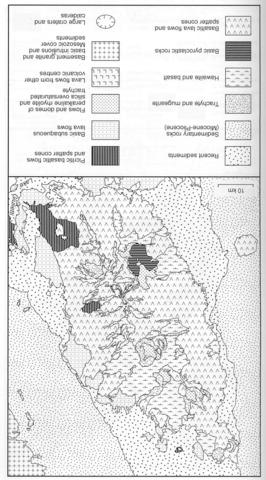stripes
The Erta Ale volcanic range is located along the northern part of the axis of the Afar (or Danakil) Depression, which is characterised by numerous north-northwest-trending normal faults and tensional features associated with active volcanism (Barberi and Varet, 1970). The range occupies an area of about 95x40 km and is built principally of the products of eruptions from fissures running parallel to the main north-northwest axis. There are six principal volcanic centres which are, from north to south, Gada Ale, Alu-Dala Filla, Borale Ale, Erta Ale, Hayli Gub (Hayli Gubbi) and Ale Bagu (Alebbagu), of which only the last does not lie on the main axis of the chain. The oldest rocks are submarine basaltic flows and hydroclastic deposits, this area having once been occupied by a branch of the Red Sea. These are succeeded in general by further basaltic and intermediate flows with the youngest rocks in most centres being rhyolites, which are generally chemically peralkaline, that form central capping volcanoes. The rhyolites are sometimes succeeded by further basaltic flows. Continuing activity is reflected in the presence within the Erte Ale caldera of a lava lake, which is described and strikingly illustrated by Tazieff (1973) with chemical data being given by Barberi et al. (1973b); fumaroles are widespread throughout the range. The volcanology of each of the principal volcanic centres is described in some detail by Barberi and Varet (1970) and illustrated with maps and many photographs. Most of the early basaltic lava flows emanated from fissures but then eruption of lavas of intermediate and rhyolitic compositions led to the production of major central cones with summit craters as well as smaller pyroclastic cones and tuff rings. The volcanic rocks form a complete series from picritic basalt through basalt, trachyte and silica oversaturated trachyte to peralkaline rhyolite, the final products of the Erta Ale volcano being comenditic. Picritic basalts contain olivine phenocrysts only whereas in the basalts bytownite or labradorite phenocrysts are the most abundant with fewer of olivine and sometimes augite. These rocks grade into andesine basalt (basaltic andesite) and what Barberi and Varet (1970) call 'dark trachyte', which is essentially basaltic trachyandesite and trachyandesite and probably mugearite of the IUGS system (Le Maitre et al., 1989). The whole series is generally hy normative and the difficulties of classification are briefly discussed by Barberi and Varet (1970) and Bizouard et al. (1980). These rocks pass into peralkaline trachytes and rhyolites that are generally glassy with only rarely tiny green pyroxenes, although these pyroxenes are not particularly sodic (Bizouard et al., 1980). Barberi et al. (1975a) discuss the evolution of the rhyolitic rocks, while a detailed account of the mineral chemistry of the whole series is given by Bizouard et al. (1980) who also present petrochemical data. Numerous rock analyses and Sr isotope data are given by Barberi et al. (1970) and Rb-Sr isotope and some other trace element data will be found in Barberi et al. (1980). Treuil et al. (1971) studied Ni, Cu and Zn in 34 rocks and Cheminee (1973) K, U and Th in some 150 rocks.
BARBERI, F. and VARET, J. 1970. The Erta Ale volcanic range (Danakil Depression, Northern Afar, Ethiopia). Bulletin Volcanologique, 34: 848-917. BARBERI, F., BORSI, S., FERRARA, G., MARINELLI, G. and VARET, J. 1970. Relations between tectonics and magmatology in the northern Danakil Depression (Ethiopia). Philosophical Transactions of The Royal Society of London, 267A: 293-311.BARBERI, F., SANTACROCE, R. and VARET, J. 1975a. Silicic peralkaline volcanic rocks of the Afar Depression (Ethiopia). Bulletin Volcanologique, 38: 755-90.BARBERI, F., CIVETTA, L. and VARET, J. 1980. Sr isotopic composition of Afar volcanics and its implication for mantle evolution. Earth and Planetary Science Letters, 50: 247-59.BIZOUARD, H., BARBERI, F. and VARET, J. 1980. Mineralogy and petrology of Erta Ale and Boina volcanic series, Afar Rift, Ethiopia. Journal of Petrology, 21: 401-36.CHEMINEE, J.-L. 1973. Évolutions des concentrations en K, U et Th dans les laves de la série differenciée de l'Erta'Ale. Révue de Géographie Physique et de Géologie Dynamique, 15: 353-72.LE MAITRE, R.W., BATEMAN, P., DUDEK, A., KELLER, J., LAMEYRE, J., LE BAS, M.J., SABINE, P.A., SCHMID, R., SORENSEN, H., STRECKEISEN, A., WOOLLEY, A.R. and ZANETTIN, B. 1989. A classification of igneous rocks and glossary of terms. Recommendations of the International Union of Geological Sciences Subcommission on the Systematics of Igneous Rocks. Blackwell, Oxford. 193 pp.TAZIEFF, H. 1973. The Erta' Ale volcano. Revue de Geographie Physique et de Geologie Dynamique, 15: 437-41.TREUIL, M and VARET, J. 1973. Critères volcanologiques, pétrologiques et géochimiques de la genèse et de la différenciation des magmas basaltiques: exemple de l'Afar. Bulletin de la Société Géologique de France, Ser. 7, 15: 506-40.TREUIL, M., VARET, J., BILLHOT, M. and BARBERI, F. 1971. Distribution of nickel, copper and zinc in the volcanic series of Erta'Ale, Ethiopia. Contributions to Mineralogy and Petrology, 30: 84-94.

